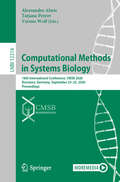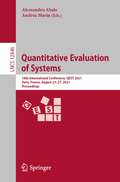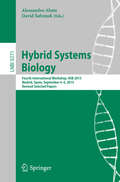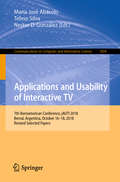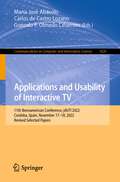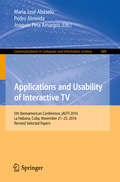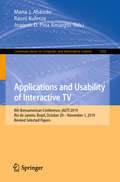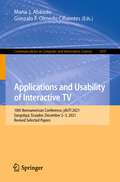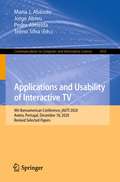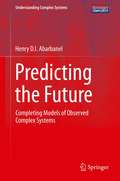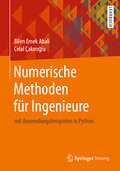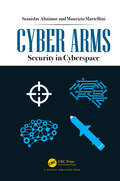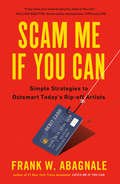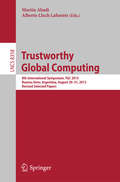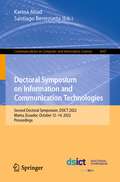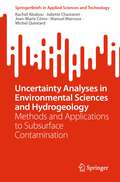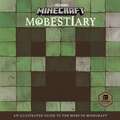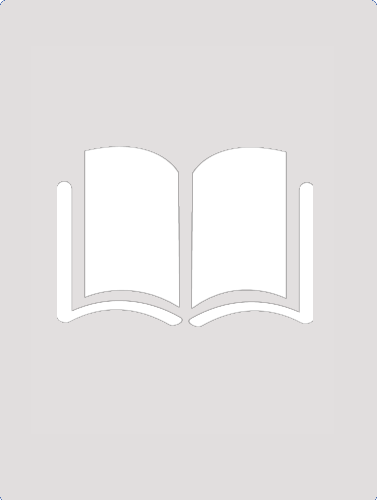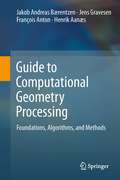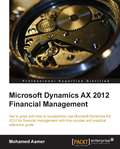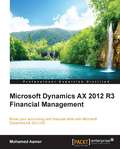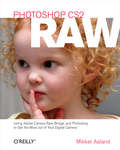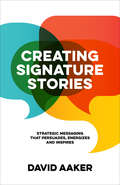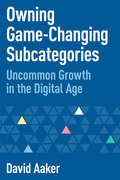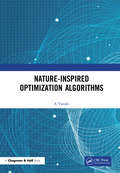- Table View
- List View
Computational Methods in Systems Biology: 18th International Conference, CMSB 2020, Konstanz, Germany, September 23–25, 2020, Proceedings (Lecture Notes in Computer Science #12314)
by Alessandro Abate Tatjana Petrov Verena WolfThis book constitutes the refereed proceedings of the 18th International Conference on Computational Methods in Systems Biology, CMSB 2020, held in Konstanz, Germany, in September 2020.*The 17 full papers and 5 tool papers were carefully reviewed and selected from 30 submissions. In addition 3 abstracts of invited talks and 2 tutorials have been included in this volume. Topics of interest include formalisms for modeling biological processes; models and their biological applications; frameworks for model verification, validation, analysis, and simulation of biological systems; high-performance computational systems biology and parallel implementations; model inference from experimental data; model integration from biological databases; multi-scale modeling and analysis methods; computational approaches for synthetic biology; and case studies in systems and synthetic biology. * The conference was held virtually due to the COVID-19 pandemic.
Quantitative Evaluation of Systems: 18th International Conference, QEST 2021, Paris, France, August 23–27, 2021, Proceedings (Lecture Notes in Computer Science #12846)
by Alessandro Abate Andrea MarinThis book constitutes the proceedings of the 18th International Conference on Quantitative Evaluation Systems, QEST 2021, held in Paris, France, in August 2021.The 21 full papers and 2 short papers presented together with 2 keynote papers were carefully reviewed and selected from 47 submissions. The papers are organized in the following topics: probabilistic model checking; quantitative models and metamodels: analysis and validation; queueing systems; learning and verification; simulation; performance evaluation; abstractions and aggregations; and stochastic models.
Hybrid Systems Biology
by Alessandro Abate David ŠafránekThis book constitutes the thoroughly referred post-workshop proceedings of the 4th International Workshop on Hybrid Systems biology, HSB 2015, held as part of the Madrid Meet 2015 event, in Madrid, Spain in September 2015. The volume presents 13 full papers together with 2 abstracts of invited sessions from 18 submissions. The scope of the HSB workshop is the general area of dynamical models in Biology with an emphasis on hybrid approaches -- by no means restricted to a narrow class of mathematical models -- and taking advantage of techniques developed separately in different areas.
Applications and Usability of Interactive TV: 7th Iberoamerican Conference, jAUTI 2018, Bernal, Argentina, October 16–18, 2018, Revised Selected Papers (Communications in Computer and Information Science #1004)
by María José Abásolo Telmo Silva Nestor D. GonzálezThis book constitutes the refereed proceedings of the 7th Iberoamerican Conference on Applications and Usability of Interactive Television, jAUTI 2018, in Bernal, Argentina, in October 2018.The 13 full papers presented were carefully reviewed and selected from numerous submissions. The papers are organized in topical sections on Contexts of application of the IDTV; Design and Implementation Techniques of IDTV Content and Services; Interaction Techniques, Technologies and Accesibility of IDTV Services; Testing and User Experience of IDTV Services.
Applications and Usability of Interactive TV: 11th Iberoamerican Conference, jAUTI 2022, Cordoba, Spain, November 17–18, 2022, Revised Selected Papers (Communications in Computer and Information Science #1820)
by María José Abásolo Carlos de Castro Lozano Gonzalo F. Olmedo CifuentesThis book constitutes the refereed proceedings of the 11th Iberoamerican Conference on Applications and Usability of Interactive TV, jAUTI 2022, Cordoba, Spain, November 17–18, 2022. The 9 full papers included in this book were carefully reviewed and selected from 25 submissions. They were organized in topical sections as follows: Content Creation and Interaction, Audiovisual Consumption, e-inclusion, Digital Infrastructure.
Applications and Usability of Interactive TV: 5th Iberoamerican Conference, jAUTI 2016, La Habana, Cuba, November 21-25, 2016, Revised Selected Papers (Communications in Computer and Information Science #689)
by María José Abásolo Pedro Almeida Joaquín Pina AmargósThis book constitutes the refereed proceedings of the 5th Iberoamerican Conference on Applications and Usability of Interactive TV , jAUTI 2016, held in conjunction with the III International Congress on Information Engineering and Information Systems, in La Habana, Cuba, in November 2016. The 11 full papers presented were carefully reviewed and selected from 30 submissions. The papers are organized in topical sections on IDTV content production and recommendation; video consumption and preservation; social TV; IDTV interaction techniques; IDTV user experiences.
Applications and Usability of Interactive TV: 8th Iberoamerican Conference, jAUTI 2019, Rio de Janeiro, Brazil, October 29–November 1, 2019, Revised Selected Papers (Communications in Computer and Information Science #1202)
by María J. Abásolo Raoni Kulesza Joaquín D. Pina AmargósThis book constitutes the refereed proceedings of the 8th Iberoamerican Conference on Applications and Usability of Interactive Television, jAUTI 2019, in Rio de Janeiro, Brazil, in October 2019.The 10 full papers presented were carefully reviewed and selected from 35 submissions. The papers are organized in topical sections on Design and Development; Second Screen and Crossmedia; Interaction Techniques and Technologies; Accessibility; User Experience.
Applications and Usability of Interactive TV: 10th Iberoamerican Conference, jAUTI 2021, Sangolquí, Ecuador, December 2–3, 2021, Revised Selected Papers (Communications in Computer and Information Science #1597)
by María J. Abásolo Gonzalo F. Olmedo CifuentesThis book constitutes thoroughly refereed and revised selected papers from the 10th Iberoamerican Conference on Applications and Usability of Interactive TV, jAUTI 2021, held in Sangolqui, Ecuador, during December 2–3, 2021.The 9 full papers included in this book were carefully reviewed and selected from 25 submissions. They were organized in topical sections as follows: Usability and UX; interaction techniques and accesibility; and technologies, services, and applications for interactive digital TV.
Applications and Usability of Interactive TV: 9th Iberoamerican Conference, jAUTI 2020, Aveiro, Portugal, December 18, 2020, Revised Selected Papers (Communications in Computer and Information Science #1433)
by María J. Abásolo Jorge Abreu Pedro Almeida Telmo SilvaThis book constitutes the refereed proceedings of the 9th Iberoamerican Conference on Applications and Usability of Interactive Television, jAUTI 2020, in Aveiro, Portugal, in December 2020.*The 12 full papers presented were carefully reviewed and selected from 35 submissions. The papers are organized in topical sections on audiovisual content and experiences; design and development of iTV applications; iTV and videos in learning; iTV for the elderly; usability and UX evaluations.*Due to the COVID-19 pandemic the conference was held online.
Predicting the Future
by Henry AbarbanelThrough the development of an exact path integral for use in transferring information from observations to a model of the observed system, the author provides a general framework for the discussion of model building and evaluation across disciplines. Through many illustrative examples drawn from models in neuroscience, geosciences, and nonlinear electrical circuits, the concepts are exemplified in detail. Practical numerical methods for approximate evaluations of the path integral are explored, and their use in designing experiments and determining a model's consistency with observations is explored.
Numerische Methoden für Ingenieure: mit Anwendungsbeispielen in Python
by Bilen Emek Abali Celal ÇakıroğluTechnische Systeme werden von Ingenieur*innen modelliert und durch numerische Methoden simuliert. Dieses Lehrbuch bietet eine unkomplizierte Einführung in numerische Methoden, mit zahlreichen, praxisrelevanten Beispielen, die mithilfe der Programmiersprache Python gelöst werden. In ingenieurwissenschaftlichen Studienrichtungen sowie in allen Forschungsprojekten sind numerische Simulationen unumgänglich, geeignete Methoden aber oft schwierig zu begreifen. Hier erklären Ingenieure die mathematischen Grundlagen der numerischen Methoden in sachlicher, dennoch simpler Sprache, mit konkreten Anwendungsbeispielen auf Papier und am Bildschirm. Die Besonderheit in diesem Buch ist, dass nicht nur Modelle der physikalischen Systeme berechnet und experimentelle Daten bearbeitet werden, sondern der Code in Python Zeile für Zeile angegeben und erklärt wird. Über die Autoren: B. E. Abali arbeitet als Dozent an der Technischen Universität Berlin sowie der Türkisch-Deutschen Universität in Istanbul, und hat an der Technischen Universität München, University of California Berkeley in den USA und Ghent University in Belgien geforscht. C. Çakıroğlu ist Dozent an der Türkisch-Deutschen Universität in Istanbul und hat an der Technischen Universität Braunschweig, dem DLR (Deutsches Zentrum für Luft- und Raumfahrt) und der University of Alberta in Kanada geforscht.
Cyber Arms: Security in Cyberspace
by Stanislav Abaimov Maurizio MartelliniThis book will raise awareness on emerging challenges of AIempowered cyber arms used in weapon systems and stockpiled in the global cyber arms race. Based on real life events, it provides a comprehensive analysis of cyber offensive and defensive landscape, analyses the cyber arms evolution from prank malicious codes into lethal weapons of mass destruction, reveals the scale of cyber offensive conflicts, explores cyber warfare mutation, warns about cyber arms race escalation and use of Artificial Intelligence (AI) for military purposes. It provides an expert insight into the current and future malicious and destructive use of the evolved cyber arms, AI and robotics, with emphasis on cyber threats to CBRNe and critical infrastructure. The book highlights international efforts in regulating the cyber environment, reviews the best practices of the leading cyber powers and their controversial approaches, recommends responsible state behaviour. It also proposes information security and cyber defence solutions and provides definitions for selected conflicting cyber terms. The disruptive potential of cyber tools merging with military weapons is examined from the technical point of view, as well as legal, ethical, and political perspectives.
Scam Me If You Can: Simple Strategies to Outsmart Today's Rip-off Artists
by Frank AbagnaleAre you at risk of being scammed? Former con artist and bestselling author of Catch Me If You Can Frank Abagnale shows you how to stop scammers in their tracks.Maybe you're wondering how to make the scam phone calls stop. Perhaps someone has stolen your credit card number. Or you've been a victim of identity theft. Even if you haven't yet been the target of a crime, con artists are always out there, waiting for the right moment to steal your information, your money, and your life.As one of the world's most respected authorities on the subjects of fraud, forgery, and cyber security, Frank Abagnale knows how scammers work. In Scam Me If You Can, he reveals the latest tricks that today's scammers, hackers, and con artists use to steal your money and personal information--often online and over the phone. Using plain language and vivid examples, Abagnale reveals hundreds of tips, including: * The best way to protect your phone from being hacked * The only time you should ever use a debit card * The one type of photo you should never post on social media * The only conditions under which you should use WiFi networks at the airport * The safest way to use an ATM With his simple but counterintuitive rules, Abagnale also makes use of his insider intel to paint a picture of cybercrimes that haven't become widespread yet.
Trustworthy Global Computing
by Martín Abadi Alberto Lluch LafuenteThis book constitutes the thoroughly refereed post-conference proceedings of the 8th International Symposium on Trustworthy Global Computing, TGC 2013, held in Buenos Aires, Argentina, in August 2013. The 15 revised full papers presented together with 3 invited talks were carefully reviewed and selected from 29 submissions. The papers cover a wide range of topics in the area of global computing and safe and reliable computation. They are organized in topical sections on security, π-calculus, information flow, models, specifications and proofs and quantitative analysis.
Doctoral Symposium on Information and Communication Technologies: Second Doctoral Symposium, DSICT 2022, Manta, Ecuador, October 12–14, 2022, Proceedings (Communications in Computer and Information Science #1647)
by Karina Abad Santiago BerrezuetaThis book constitutes the refereed proceedings of the Second Doctoral Symposium on Information and Communication Technologies, DSICT 2022, held in Manta, Ecuador, in October 2022. The 15 full papers were thoroughly reviewed and selected from the 72 submissions. The papers present research in areas of intelligent systems, artificial intelligence, ICTs and their applications to the real world.
Uncertainty Analyses in Environmental Sciences and Hydrogeology: Methods and Applications to Subsurface Contamination (SpringerBriefs in Applied Sciences and Technology)
by Rachid Ababou Juliette Chastanet Jean-Marie Côme Manuel Marcoux Michel QuintardThis book highlights several methods and quantitative implementations of both probabilistic and fuzzy-based approaches to uncertainty quantification and uncertainty propagation through environmental subsurface pollution models with uncertain input parameters. The book focuses on methods as well as applications in hydrogeology, soil hydrology, groundwater contamination, and related areas (e.g., corrosion of nuclear waste canisters). The methods are illustrated for a broad spectrum of models, from non-differential I/O models to complex PDE solvers, including a novel 3D quasi-analytical model of contaminant transport, and a site-specific computer model of dissolved contaminant migration from a DNAPL (Dense Non Aqueous Phase Liquid) pollution source.
Minecraft: Mobestiary (Minecraft Series)
by Mojang Ab The Official Minecraft TeamWith insider gaming info and tips, this is the official, definitive, fully illustrated guide to mobs—and how to outsmart them—in Minecraft. <p><p>Minecraft: Mobestiary reveals the secrets of every mob in the game. You’ll find little-known facts about passive, neutral, hostile, utility, and boss mobs, as well as more general information about their locations, behaviors, threat levels, and drops. <p><p>Written by Alex Wiltshire, author of Minecraft: Blockopedia and former editor at Edge magazine, who has made it his life’s work to study Minecraft’s mobs. Illustrated with field sketches throughout by Anton Stenvall.
Quantum Computing since Democritus
by Scott AaronsonWritten by noted quantum computing theorist Scott Aaronson, this book takes readers on a tour through some of the deepest ideas of maths, computer science and physics. Full of insights, arguments and philosophical perspectives, the book covers an amazing array of topics. Beginning in antiquity with Democritus, it progresses through logic and set theory, computability and complexity theory, quantum computing, cryptography, the information content of quantum states and the interpretation of quantum mechanics. There are also extended discussions about time travel, Newcomb's Paradox, the anthropic principle and the views of Roger Penrose. Aaronson's informal style makes this fascinating book accessible to readers with scientific backgrounds, as well as students and researchers working in physics, computer science, mathematics and philosophy.
Guide to Computational Geometry Processing
by Henrik Aanæs François Anton J. Andreas Bærentzen Jens GravesenThis book reviews the algorithms for processing geometric data, with a practical focus on important techniques not covered by traditional courses on computer vision and computer graphics. Features: presents an overview of the underlying mathematical theory, covering vector spaces, metric space, affine spaces, differential geometry, and finite difference methods for derivatives and differential equations; reviews geometry representations, including polygonal meshes, splines, and subdivision surfaces; examines techniques for computing curvature from polygonal meshes; describes algorithms for mesh smoothing, mesh parametrization, and mesh optimization and simplification; discusses point location databases and convex hulls of point sets; investigates the reconstruction of triangle meshes from point clouds, including methods for registration of point clouds and surface reconstruction; provides additional material at a supplementary website; includes self-study exercises throughout the text.
Microsoft Dynamics AX 2012 Financial Management
by Mohamed AamerThis book is a practical, hands-on guide that covers both the basic and advanced concepts of financial management using Microsoft Dynamics AX.Microsoft Dynamics AX Financial Management is for Microsoft Dynamics AX solution architects, application consultants, support engineers, pre-technical sales consultants, and project managers on the partner side, as well as chief financial officers, financial controllers, accounting managers, key users, business analysts, and chief information officers on the customer side. A basic knowledge of financial terms, concepts, and Microsoft Dynamics AX terminologies will help you better understand the concepts covered in this book.
Microsoft Dynamics AX 2012 R3 Financial Management
by Mohamed AamerThis book is intended for application consultants, controllers, CFOs, and other professionals who are engaged in a Microsoft Dynamics AX implementation project. Basic knowledge of financial terms, concepts, and Microsoft Dynamics AX terminologies is required.
Photoshop CS2 RAW
by Mikkel AalandThe RAW file format is the uncompressed data file captured by a digital camera's electronic sensor. When your camera saves an image in RAW format, settings like white balance, sharpening, contrast and saturation are not applied to the image but are saved instead in a separate header. Because RAW files remain virtually untouched by in-camera processing, they are essentially the digital equivalent to exposed but undeveloped film. This makes RAW an increasingly popular format with amateur and professional digital photographers, because it affords greater flexibility and control during the editing process-if you know how to work with RAW files. Most digital camera manufacturers supply their own software for converting RAW data, as do some third party vendors. Increasingly, however, the RAW converter of choice is a plug-in included in the latest version of Adobe Photoshop, the most popular and widely-used digital image editing tool in the world. Adobe Photoshop CS2 is emerging as the best place to edit RAW images, and the best way to master this new format is with Photoshop CS2 RAW. An important book dedicated to working with RAW in Photoshop, this comprehensive guide features a unique design that helps readers grasp the subject through visual instruction and prompts. The entire RAW process is explored, from shooting to using the Adobe plug-in converter and new Bridge navigation software. The primary focus of Photoshop RAW is, as the title suggests, Photoshop editing technique: automating RAW workflow, correcting exposures, extending exposure range, manipulating grayscale and working with the new DNG (Digital Negative) open standard that Adobe supports. Presented by photographer Mikkel Aaland, a pioneer of digital photography and author of eight books, including O'Reilly's Photoshop for the Web and the award-winning Shooting Digital, Photoshop CS2 RAW investigates and instructs in an accessible visual style. Required reading for professionals and dedicated photo hobbyists alike.
Creating Signature Stories: Strategic Messaging that Persuades, Energizes and Inspires
by David AakerStories are orders of magnitude which are more effective than facts at achieving attention, persuading, being remembered, and inspiring involvement. Signature stories—intriguing, authentic, and involving narratives—apply the power of stories to communicate a strategic message. Marketing professionals, coping with the digital revolution and the need to have their strategic message heard internally and externally, are realizing that a digital strategy revolves around content and that content is stories.Creating Signature Stories shows organizations how to introduce storytelling into their strategic messaging, and guides organizations to find, or even create, signature stories and leverage them over time. With case studies built into every chapter, organizations will realize the power of storytelling to energize readers, gain visibility, persuade audiences, and inspire action.
Owning Game-Changing Subcategories: Uncommon Growth in the Digital Age
by David AakerOwning Game-Changing Subcategories is about creating organizational growth in the digital age by creating and owning game-changing subcategories fueled by digital.Owning Game-Changing Subcategories outlines the path to finding, managing, and leveraging new subcategories. In the digital age, the path has been made wider, shorter, and more frequently traveled. Throughout Owning Game-Changing Subcategories, David Aaker discusses certain aspects of the digital age that alter this path, such as E-commerce providing fast, inexpensive market access bypassing the cost of gaining distribution into storefront retailers or creating personal sales teams and social media and websites enabling communication on steroids in comparison with traditional use of advertising or events. Growth is not only a success measure but also creates energy and opportunity for customers and employees. And such growth almost never occurs with “my brand is better than your brand” marketing. Owning Game-Changing Subcategories explores the only ways to grow a business (with rare exceptions) which is to:develop new “must haves” that define a game-changing subcategory that provides a new or markedly superior buying or use experience or brand relationship to a core customer base;become the exemplar brand that represents the subcategory and drives its visibility, positioning, and success; and create barriers to competitors that could include “must-have” associations and a basis of relationships that go beyond functional benefits.
Nature-Inspired Optimization Algorithms
by Vasuki ANature-Inspired Optimization Algorithms, a comprehensive work on the most popular optimization algorithms based on nature, starts with an overview of optimization going from the classical to the latest swarm intelligence algorithm. Nature has a rich abundance of flora and fauna that inspired the development of optimization techniques, providing us with simple solutions to complex problems in an effective and adaptive manner. The study of the intelligent survival strategies of animals, birds, and insects in a hostile and ever-changing environment has led to the development of techniques emulating their behavior. This book is a lucid description of fifteen important existing optimization algorithms based on swarm intelligence and superior in performance. It is a valuable resource for engineers, researchers, faculty, and students who are devising optimum solutions to any type of problem ranging from computer science to economics and covering diverse areas that require maximizing output and minimizing resources. This is the crux of all optimization algorithms. Features: Detailed description of the algorithms along with pseudocode and flowchart Easy translation to program code that is also readily available in Mathworks website for some of the algorithms Simple examples demonstrating the optimization strategies are provided to enhance understanding Standard applications and benchmark datasets for testing and validating the algorithms are included This book is a reference for undergraduate and post-graduate students. It will be useful to faculty members teaching optimization. It is also a comprehensive guide for researchers who are looking for optimizing resources in attaining the best solution to a problem. The nature-inspired optimization algorithms are unconventional, and this makes them more efficient than their traditional counterparts.
